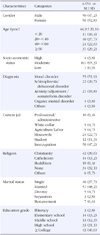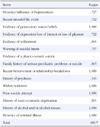Abstract
Purpose
Assessment of suicide risk is a critical task for nurses, especially for nurses working with psychiatric inpatients. The purpose of this study was to verify the reliability and validity of the Nurses' Global Assessment of Suicide Risk (NGASR) for psychiatric inpatients.
Methods
This study was methodological study. A scale composed of 15 items was used with 106 psychiatric inpatients in open and closed psychiatric units of a tertiary hospital. Cohen's kappa coefficient, Intraclass correlation, factor analysis and Jonckheere-Terpstra Test for Ordered Alternatives were used for statistic analysis.
Results
Main results were as follows; Reliability of the scale was supported with a total intraclass correlation coefficient of .890 (range from .722 to 1.000). In investigating construct validity, 15 items loaded on six factors which explained 63.4% of total variance. Also the Jonckheere-Terpstra test revealed a significant trend in the order of median scores of NGASR across the three groups of Evaluation of Suicide Risk (ESR). These results supported the criterion-related validity of the scale.
Figures and Tables
 | Figure 1Boxplot of the nurses' global assessment of suicide risk (NGASR) score across change in evaluation of suicide risk. |
References
1. Bagge C, Osman A. The Suicide Probability Scale: Norms and factor structure. Psychol Rep. 1998. 83:637–638.
2. Brown GK. A review of suicide assessment measures for intervention research with adults and older adults. 2001. Retrieved March 30, 2010. from http://www.suicidology.org/c/document_library/get_file?folderId=235&name=DLFE-113.pdf.
3. Combs MD, Romm S. Psychiatric inpatient suicide: A literature review. Prim Psychiatry. 2007. 14(12):67–74.
4. Cutcliffe JR, Barker P. Considering the care of the suicidal client and the case for 'engagement and inspiring hope' or 'observations'. J Psychiatr Ment Health Nurs. 2002. 9:611–621.
5. Cutcliffe JR, Barker P. The Nurses' Global Assessment of Suicide Risk(NGASR): Developing a tool for clinical practice. J Psychiatr Ment Health Nurs. 2004. 11:393–400.
6. Gau SS, Chen CH, Lee CT, Chang JC, Cheng AT. Development of a Chinese version of the Suicide Intent Scale. Suicide Life Threat Behav. 2009. 39:332–342.

7. Hermes B, Deakin K, Lee K, Robinson S. Suicide risk assessment 6 steps to better instrument. J Psychosoc Nurs Ment Health Serv. 2009. 47(6):44–49.

8. Holden RR, DeLisle MM. Factor analysis of the Beck Scale for suicide ideation with female suicide attempters. Assessment. 2005. 12:231–238.
9. Kim YB, Lee JS. An analysis of suicide concepts. J Korean Acad Psychiatr Ment Health Nurs. 2003. 12:394–401.
10. Lee EO, Gu MO, Kwon IG, Kim KS, Kim IJ, Kim JI, et al. Research evaluation & utilization. 2007. Seoul: Koonja.
11. Lee MS. The suicide of the psychiatric patients and the responsibility of the hospital. Korean J Leg Med. 1996. 20:94–100.
12. Lynch MA, Howard PB, El-Mallakh P, Matthews JM. Assessment and management of hospitalized suicidal patients. J Psychosoc Nurs Ment Health Serv. 2008. 46(7):45–52.
13. Mills PD, DeRosier JM, Ballot BA, Shepherd M, Bagian JP. National patient safety goals. Inpatient suicide and suicide attempts in Veterans Affairs hospitals. Jt Comm J Qual Patient Saf. 2008. 34:482–488.
14. Park JU. The relationship between job stress and burnout of psychiatric nurses. 2007. Seoul: Ewha Womans University;Unpublished master's thesis.

15. Sadock BJ, Sadock VA. Synopsis of psychiatry: Behavior sciences/clinical psychiatry (9). 2003. Philadelphia, PA: Lippincott Willians & Wilkins.





 PDF
PDF ePub
ePub Citation
Citation Print
Print







 XML Download
XML Download